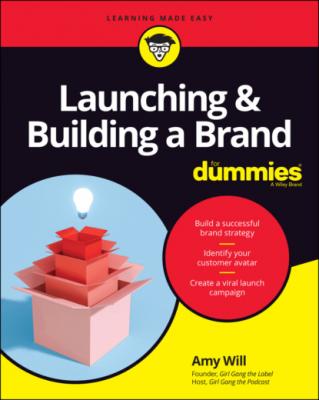ТОП просматриваемых книг сайта:
Launching & Building a Brand For Dummies. Amy Will
Читать онлайн.Название Launching & Building a Brand For Dummies
Год выпуска 0
isbn 9781119748052
Автор произведения Amy Will
Жанр Малый бизнес
Издательство John Wiley & Sons Limited
For more about getting grants, check out Grant Writing For Dummies, 6th Edition, by Beverly A. Browning (John Wiley & Sons, Inc.).
Financing with debt and equity
Traditionally, businesses obtain the money they need to start and grow with either debt or equity. In other words, they borrow money from banks or sell a stake in their business/brand to investors. When you’re creating a business/brand, you have the same options.
Financing with debt: Borrowing money
If you don’t have enough money to build and launch your business/brand, or if you prefer not to risk your own money, you may be able to borrow money from people or banks. The people may be family members, friends, or venture capitalists. You meet with them to pitch your idea, and if they think it has potential for success (and trust that you’ll pay back the loan), they’ll agree to loan you the money. They may charge interest, or they may not.
If you don’t like that option, you can try pitching your idea to a bank, which will charge you interest. Before approaching a loan officer at the bank, prepare for a meeting by gathering the following items:
Your business plan
The specific amount of money you need to borrow
Legal documents pertaining to your business, including your articles of incorporation or DBA; any licenses you need to operate; your EIN; and any applicable patents, trademarks, or copyrights you own or have applied for
Your credit score
Your net worth (the value of everything you own minus what you owe), along with a list of assets and debts
Proof of any money you have in savings, such as recent bank statements
Proof of any income from sources such as your day job and investments (pay stubs or recent tax returns)
Financing with equity: Selling a stake in your business/brand
An alternative to borrowing money is selling a stake in your business/brand to investors. You can offer your sister-in-law 30 percent ownership of your koi-pond business in exchange for $50,000, for example. If you do something like that, of course, I strongly encourage you to hire an attorney to draw up an agreement.
You can also sell shares in your business, which is way beyond the scope of this book. To sell shares, your business needs to be structured as a C corp or S corp. You can sell various types of stock in a business, including common stock, preferred stock, and convertible preferred stock, to name a few. If your head is spinning, that’s my point: Consult an attorney or a stockbroker to explain your options and suggest what’s best for your particular situation and preferences.
Exploring alternative financing options
Merchant cash advance: If you’re selling stuff online and need some quick cash to cover an unforeseen expense, such as the cost of additional product when you experience a bump in sales, consider a merchant cash advance — a financing option offered by companies such as Kabbage (https://www.kabbage.com) through Shopify. Here’s how Kabbage works: You apply for a loan, and if it’s approved, Kabbage deposits the money in your bank account. Then it takes a percentage of your Shopify sales until the loan is paid off.
Online business line of credit (LOC): Banks offer LOCs, but if your business needs some additional cash flow in a hurry, consider an online business LOC, which is easier and faster to get. With an LOC, you’re approved for a certain maximum loan amount and draw money out as you need it, paying interest only on the money you borrow. An example of a company that offers online business LOCs is OnDeck (https://www.ondeck.com), which offers an instant funding option that provides access to up to $10,000.
Business credit cards: One common but often-overlooked option for short-term financing is credit cards, particularly business credit cards, which work just like personal credit cards but for businesses. Search the web for “business credit card,” and you’ll find a host of options.
Microloans: Microloans are small loans with relatively low interest rates offered by traditional lenders, individuals, or groups of people. These loans are good options to consider if you don’t have much collateral or credit history. They’re typically prioritized for entrepreneurs in undeveloped countries and communities and for minority business owners. You can find microlenders through organizations such as Headway Capital (https://www.headwaycapital.com/microloans) and Accion (https://www.accion.org).
Crowdfunding: With crowdfunding, you get a lot of people to donate, lend, or invest small amounts of money in your business. One of the most popular crowdfunding sites for businesses is Kickstarter (https://www.kickstarter.com). With Kickstarter, you post your project, your funding goal, and your deadline, and members can choose to chip in to make it happen. Financial backers get nothing in return, except maybe a T-shirt, a sample of your product, or a copy of a book you wrote. Mostly, they get the satisfaction of having helped bring something of value, fun, or interest into the world.
Chapter 3
Positioning and Defining Your Brand
IN THIS CHAPTER
When you get to the point of thinking about building and launching a brand, you usually have a brand in mind, but the concept may still be a little (or very) fuzzy. You may have a clear vision of the business, product, or service you’re bringing into the world, but you’ve given little thought to how

